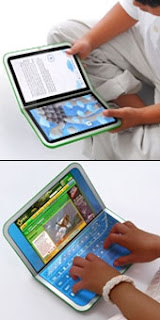At the celebration Alan Kay was present. In an interview with Wired, he summed up the characteristics of the Dynabook. He defined portability as "being able to carry something else too" and "hand portability" as "being able to grab something else, too." The device should weigh roughly 2 pounds. The laptop should also have a screen of about 1 million pixels.
 A mock-up of Dynabook.
A mock-up of Dynabook.The first real laptops came onto the market from the eighties onwards. I have been a fan of laptops from the beginning. My museum collection contains a few artefacts. My Zenith Model 100 of 1983 (still working and now 25 years old!) was the closest to the Dynabook design, as it contained a keyboard with a fixed screen of 8 rules. Later all laptops separated the screen from the keyboard.
 In front is the vintage Zenith Model 100 (1983). In the background are on the right the Sony Vaio PCG-C1F (1999) and on the left the ASUS EEE (2008).
In front is the vintage Zenith Model 100 (1983). In the background are on the right the Sony Vaio PCG-C1F (1999) and on the left the ASUS EEE (2008). Interesting is the fact that the latest designs of the e-readers like the iRex DR 1000 and PlasticLogic are like the reading pane Alan Kay designed. Yet he attributed more PC functions to Dynabook; the Kindle would get closer.
Interesting is the fact that the latest designs of the e-readers like the iRex DR 1000 and PlasticLogic are like the reading pane Alan Kay designed. Yet he attributed more PC functions to Dynabook; the Kindle would get closer. The commemorative meeting in the Computer Museum was also attended by Mary Lou Jepsen, who was involved in the developement of the 100 dollar computer or the One Laptop Per Child (OLPC) project. She is now involved in the development of the successor. Her view on the laptop in general and the display in particular (see illustrations) has been praised by Alan Kay.
The commemorative meeting in the Computer Museum was also attended by Mary Lou Jepsen, who was involved in the developement of the 100 dollar computer or the One Laptop Per Child (OLPC) project. She is now involved in the development of the successor. Her view on the laptop in general and the display in particular (see illustrations) has been praised by Alan Kay.
Blog Posting Number: 1260
Tags: laptop, e-reader

No comments:
Post a Comment